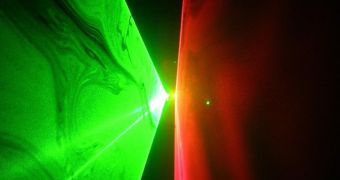One might imagine that light can basically pass through any hole no matter how small, but the truth is that when presented with a hole smaller than its own wavelength, light finds it especially difficult to penetrate to the other side, but it will nonetheless. Researchers Dr. Aurele Adam and Professor Paul Plancken from the Delft University of Technology used for the first time a technique involving far-infrared light, known as Terahertz radiation, to show how this process actually takes place.
By doing so, they may have opened new doors towards the improvement of Terahertz microscopy, a relatively new imaging technique, and Terahertz microspectroscopy, a method used to identify extremely small amounts of matter with the help of light. Terahertz radiation with a frequency of 1012 Hz was used during the experiment to measure the electrical field of the light in the vicinity of the tiny hole, as opposed to the usual technique involving the measurement of the light intensity, as it reveals more about light behavior in these particular situations.
The light's electrical field is measured in relation with the refractive-index of the crystal in which the tiny hole is created with the help of a laser beam. Measuring the slight variations in the crystal's refractive index ultimately reveals the light's electrical field behavior in the vicinity of the hole.
"This process has never been mapped properly, mainly because the technology was not available to do so", says Planken. The process was first described theoretically in the middle of the 20th century, through the Bouwkamp model, a Dutch researcher who worked at Philips. Bouwkamp's model suggests that the strength of the electrical field of the light increases at the edges of the tiny hole, while an electrical field intensity minimum is experienced while dropping the frequency of the Terahertz radiation.
The results of the experiment revealed the Terahertz light can penetrate holes up to fifty times smaller than the wavelength and exit the other side of the crystal slow enough to allow researchers to observe that light moves outwards, away from the hole, in a circular wave similar to that of disturbances created by a stone on a water surface.
The findings of the experiment seem to be matching the predictions made using Bouwkamp's model, and may lead to the creating of highly improved Terahertz light sources, because the smaller the light source, the sharper the images created using this technique. The increased frequency of Terahertz radiation allows it to penetrate materials that are usually opaque to visible light, such as paper, plastics or clothes, although the technique cannot yet yield sharp images.

 14 DAY TRIAL //
14 DAY TRIAL //